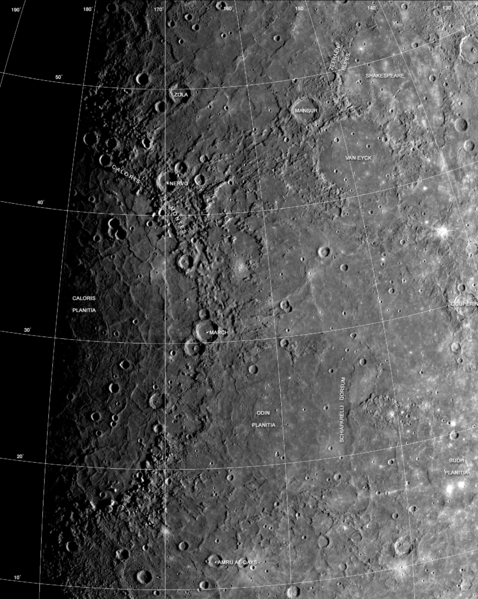[/caption]
The geology of Mercury is similar to the geology of the Moon; although, Mercury is a much denser planet with a larger liquid iron core. But when you look at photographs of Mercury, it really looks like you’re looking at the Moon. The surface of Mercury is covered by impact craters and lava plains.
Planetary scientists can judge the age of a planet’s surface by the number and size of impact craters. In the case of Mercury, there are enough craters that scientists think that the surface of Mercury is largely unchanged for billions of years. It’s believed that the surface of Mercury is geologically inactive; although, only 55% of the surface has been mapped in enough detail to see its geology.
Mercury formed with the rest of the Solar System about 4.6 billion years ago. After that was a period of heavy bombardment by asteroids and comets; this lasted until 3.8 billion years ago. All of the planets in the Solar System were beaten up during the Late Heavy Bombardment period, but we can still see the scars on Mercury and the Moon. Some of the largest craters in this period were filled with lava from Mercury’s interior. It’s believed that vulcanism on Mercury ended during its first 700 800 million years.
Craters on Mercury can be small bowl-shaped pockets, or huge impact craters hundreds of kilometers across. The largest crater on Mercury is the Caloris Basin, measuring 1,550 km across. There have been about 15 large impact basins identified on Mercury. Just like the Moon, the larger craters have bright rays of material; it’s brighter because it hasn’t been as weathered by impacts.
One of the unique places on Mercury are the regions around its poles. Astronomers using radar telescopes have detected large deposits of water ice around Mercury’s poles. It’s believed these deposits of ice are located in deep craters near Mercury’s poles where they’re always in shadow. It’s possible these were deposited by comet impacts billions of years ago.
We have written many stories about Mercury here on Universe Today. Here’s an article about a the discovery that Mercury’s core is liquid. And how Mercury is actually less like the Moon than previously believed.
Want more information on Mercury? Here’s a link to NASA’s MESSENGER Misson Page, and here’s NASA’s Solar System Exploration Guide to Mercury.
We have also recorded a whole episode of Astronomy Cast that’s just about planet Mercury. Listen to it here, Episode 49: Mercury.
References:
NASA Solar System Exploration: Mercury
NASA: The Solar System’s Big Bang

